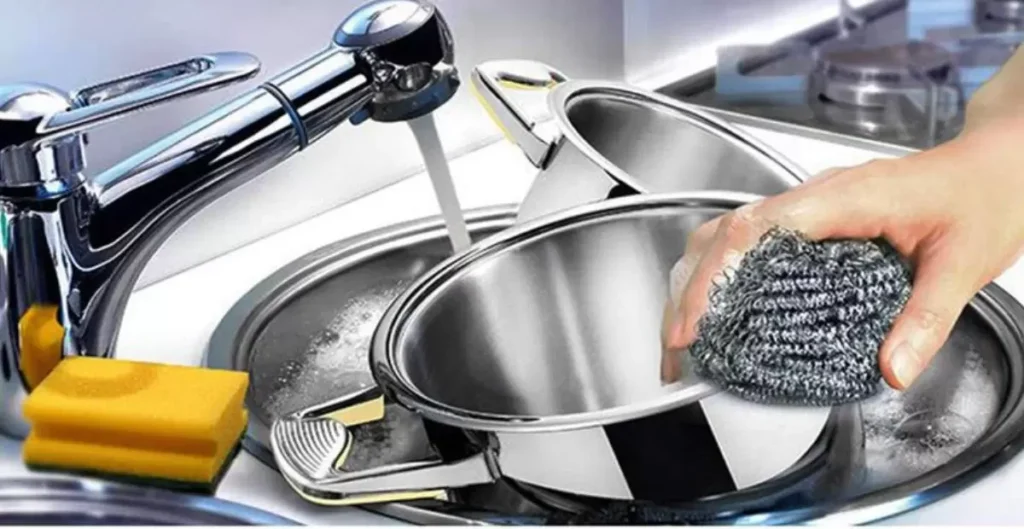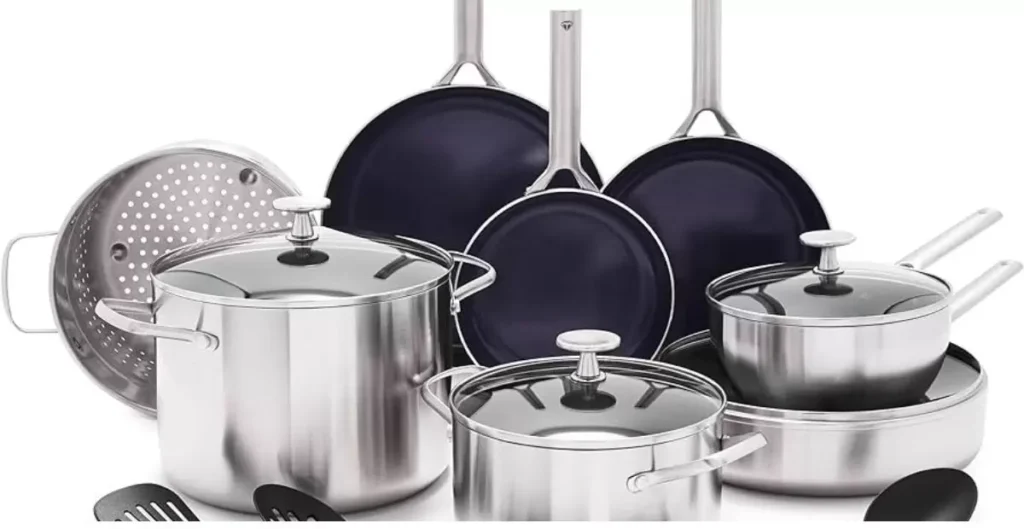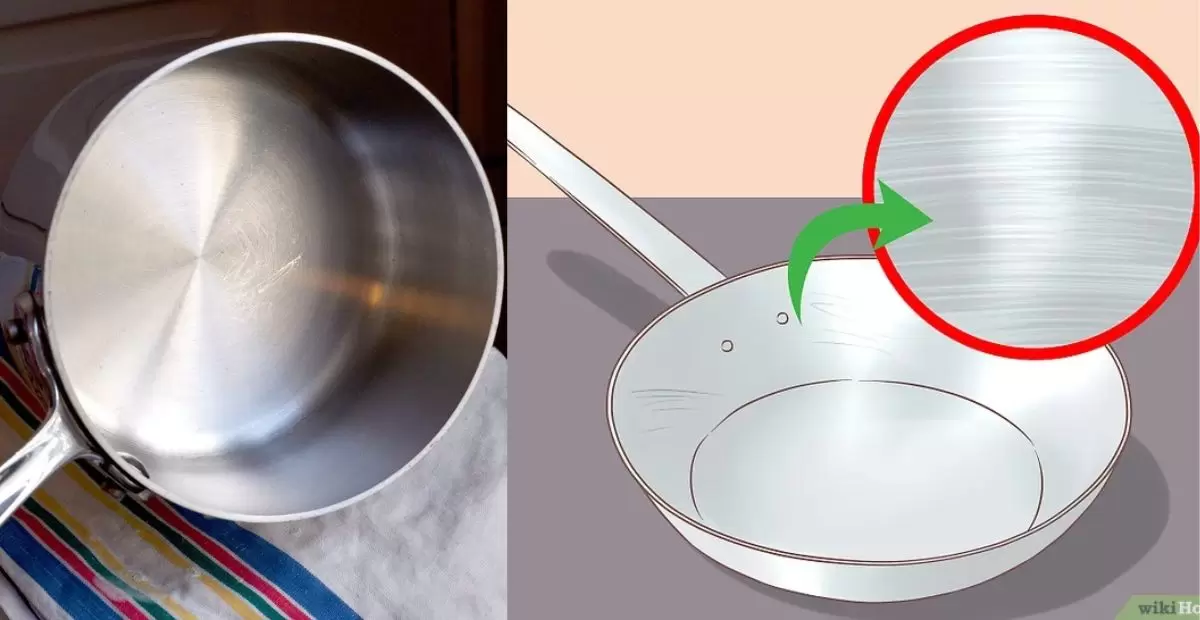Metal utensils refer to pots, pans, tools, cutlery and bakeware made from metallic elements instead of plastics, wood or ceramics. Common metal options include stainless steel, aluminum, copper, cast iron and silver. Their hardness and thermal conduction suits cooking tasks.
Stainless steel’s shine, durability and rust protection makes it a coveted cookware choice. Will metal utensils scratch stainless steel? But its daily use with various metal cooking utensils raises concerns.
Metal utensils can scratch stainless steel pans, pots and grills depending on the hardness and roughness of the metals. Minor surface scratches pose little functional impact. Proper use also minimizes risks of degrading food taste or safety from scratched cookware.
Hardness Properties of Stainless Steel
Stainless steel boasts impressive hardness properties, making it a favored material in various industries. The hardness of stainless steel is derived from its composition, primarily iron, chromium, and other alloying elements. The addition of chromium forms a protective oxide layer on the surface, known as passivation, it increases its overall hardness.
This layer not only provides a sleek appearance but also shields the steel from wear and tear. The hardness of stainless steel varies depending on the specific grade and heat treatment it undergoes during manufacturing. Engineers and designers often select stainless steel for applications requiring durability and resistance to deterioration over time.
Risks of Metal Utensil Scratches
While stainless steel is renowned for its durability, metal utensil scratches pose a potential risk to its surface integrity. Despite its hardness, stainless steel is not entirely immune to abrasion. The use of metal utensils, especially those with sharp edges, can create visible scratches on the surface of cookware and other stainless steel items.
These scratches may compromise the protective oxide layer, potentially leading to localized corrosion and reduced resistance to rust. To mitigate these risks, it is advisable to use utensils made from softer materials like wood or silicone, preserving the aesthetic appeal and longevity of stainless steel products.
Stainless Steel Outer Layer Protection
The outer layer protection of stainless steel is a key factor in its longevity and performance. The chromium content in stainless steel plays a pivotal role in forming a passive oxide layer on the surface, which acts as a barrier against corrosive elements. This protective layer not only enhances the steel’s resistance to rust and staining but also contributes to its lustrous appearance.
Manufacturers often employ techniques such as electroplating or passivation during the production process to reinforce this outer layer. The selection of appropriate grades and finishes allows for customization based on the intended application, ensuring optimal protection against environmental factors.
Effects of Excessive Scrubbing Force

Overenthusiastic scrubbing may seem like a quick solution for cleaning, but it can have detrimental effects on your utensils. Excessive scrubbing force, especially when using abrasive pads or steel wool, can strip away the protective coatings on pans and pots, leaving them susceptible to corrosion.
This aggressive cleaning approach can also scratch and damage the surfaces of non-stick cookware, compromising their effectiveness and longevity. Constant use of excessive force may wear down the finish of your utensils, making them more prone to sticking and burning during cooking.
Differences in Utensil Metals and Coatings
Choosing the right utensils involves understanding the nuances of various metals and coatings available in the market. Stainless steel utensils, for example, are durable and resistant to rust, making them a reliable choice for long-term use.
Each metal and coating has its unique properties, affecting cooking results and maintenance requirements. By being mindful of these differences, you can make informed choices that align with your cooking preferences and ensure the longevity of your utensils.
Table: Differences in Utensil Metals and Coatings
| Metal/Coating | Characteristics | Considerations |
| Stainless Steel | Corrosion-resistant, durable | Ideal for cookware, cutlery; easy to clean |
| Aluminum | Lightweight, quick heat conduction | May react with acidic foods; handle with care |
| Copper | Excellent heat conductivity | Requires careful maintenance to prevent tarnish |
| Non-stick Coatings | Easy food release, may scratch easily | Delicate handling needed; great for certain dishes |
Benefits of Proper Utensil Selection

Selecting the right utensils is crucial for optimal cooking and kitchen efficiency. Beyond aesthetics, factors like heat conductivity, durability, and ease of cleaning matter. When it comes to maintaining stainless steel pans, avoid metal utensils to preserve their longevity and non-stick properties.
Choosing utensils with suitable materials and coatings ensures even heat distribution, preventing uneven cooking and burnt spots. The right utensils contribute to the longevity of your cookware, saving you money in the long run. Using non-abrasive utensils on non-stick surfaces, for example, preserves the coating and enhances the lifespan of your pans.
Importance of Scratch Prevention
Scratch prevention is paramount for preserving the aesthetic appeal and longevity of various surfaces, be it electronic devices, furniture, or automobiles. Prevention not only maintains the visual integrity but also safeguards against potential functional deterioration. For electronic gadgets, screen protectors and cases act as effective barriers against scratches.
In furniture and automotive contexts, employing soft felt pads on the feet of chairs or utilizing car wax can prevent unsightly scratches. Beyond cosmetics, scratch prevention plays a pivotal role in maintaining the structural integrity of materials, ultimately saving time and resources that would otherwise be spent on repairs.
Repairing Light Surface Damage
Addressing light surface damage is crucial to maintaining the overall appearance of objects and surfaces. For minor scratches on glass or electronic screens, a simple solution involves applying a small amount of toothpaste or baking soda mixed with water, gently rubbing the affected area in circular motions, and then wiping it clean.
This method can often eliminate superficial blemishes without causing further harm. Additionally, for wooden furniture with light scratches, using a mixture of olive oil and vinegar can help mask the damage by moisturizing and darkening the exposed wood. It’s essential to approach light surface damage with caution, using non-abrasive materials and methods to avoid exacerbating the issue.
Restoring Heavier Utensil Scratches
Restoring heavier utensil scratches requires a more targeted and deliberate approach. For stainless steel appliances or cookware, a paste made from baking soda and water can be applied to the scratched area, gently buffed with a soft cloth or sponge, and then thoroughly rinsed.
This method helps to diminish the appearance of deeper scratches and restore the stainless steel’s shine. In the case of wooden furniture with substantial scratches, using a wood filler or touch-up marker that matches the original color can effectively mask the damage. It’s crucial to follow up with a protective coating, such as varnish or wax, to ensure a seamless finish.
Choosing Alternative Cookware
When selecting alternative cookware, consider both material and functionality. Non-stick ceramic pans provide a healthier option, as they don’t release harmful chemicals when heated. They are also easy to clean and maintain. Stainless steel cookware is durable and resistant to rust, making it a long-lasting choice.
Look beyond traditional pots and pans and consider the versatility of multi-functional appliances. Instant Pots, for instance, combine several kitchen appliances into one, streamlining the cooking process and saving both time and counter space. Clay cookware, such as tagines, offers a traditional and flavorful method of cooking. Its porous nature enhances the taste of food and retains moisture.
FAQs
How do micro-scratches from metal utensils impact food safety?
Minor scratches pose no food safety risks as stainless steel remains non-reactive to acids and liquids inside scratched surfaces.
Can certain stainless steel grades better resist metal marks?
Yes, 400 series ferritic and martensitic grades offer slightly better scratch resistance over 300 series steel from their tighter grain alignment.
Do all metal cooking utensils equally scratch steel?
No, copper and aluminum mark steel worse than stainless steel. Also, rusted cast iron or rough-edged tools scratch deeper than smooth-surfaced metallics.
Conclusion
Using non-abrasive utensils and avoiding aggressive scouring protects stainless steel’s appearance best but does not eliminate all microscopic scratches. Focus instead on the retained non-reactive nature and safe longevity stainless steel cookware provides despite eventual wear.
Stainless steel’s durable scratch resistance makes clear surface marks from metal utensils mostly pose aesthetic concerns. With care, limiting scratches, quality stainless steel cookware serves reliably for decades thanks to its ruggedness.
